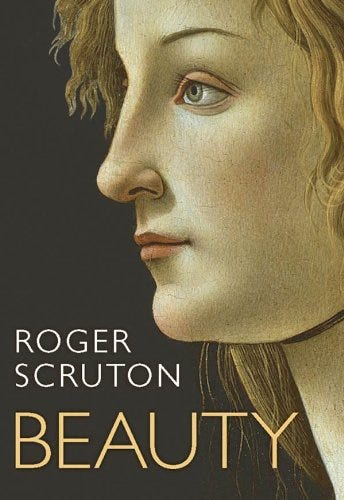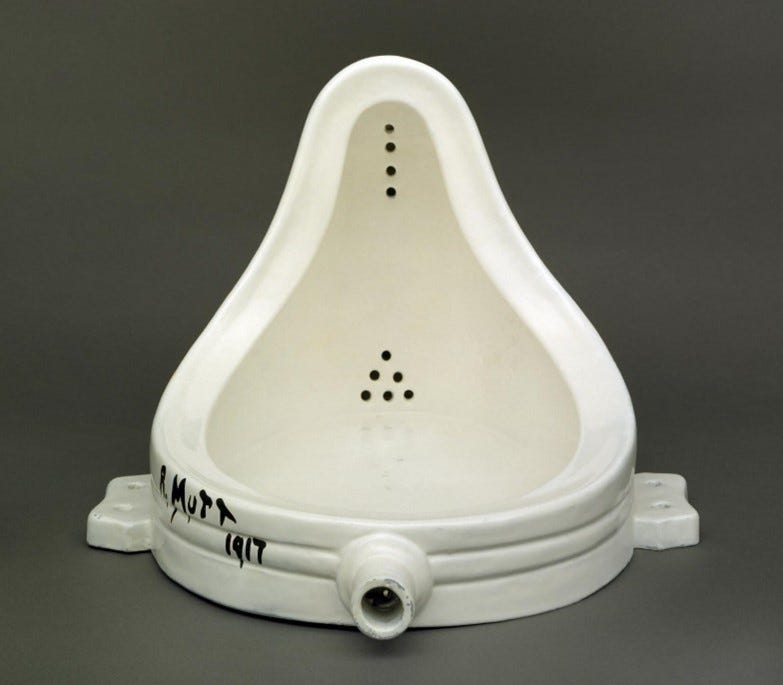Welcome to Citizen Scholar! Since launching three months ago we’re reaching hundreds of people a week, so we thank you for your support. If you enjoy our writing on civic virtue and individual excellence, we humbly ask you to share Citizen Scholar with your family members and friends who may enjoy it. The contents of the audio and text formats are identical and meant to accommodate your preferences. Please let us know if you have any feedback - we’re always looking for ways to improve!
Introduction
We knew the meaning of political philosophy and metaphysics well before we understood the definition of aesthetics as a branch of philosophy. The modern world usually relegates the contemplation of beauty to a quaint hobby, typified by visiting an art museum or hiking up a mountain to soak in an awe-inspiring view. At Citizen Scholar, we’ve long since concluded that the appreciation of beauty across various spheres of life must be central to the citizen seeking a life well-lived. Admittedly, this instinctual belief hasn’t always rested on the most rigorous rational foundations. Therefore, we decided to consult with the late, great Sir Roger Scruton.
Scruton’s primary interest as a philosopher was in aesthetics. To read his 2009 book, Beauty, is to enter the mind of an intellectual behemoth who invested a lifetime of thought into the subject. Early in the book, he issues a warning that this isn’t the intellectual equivalent of a wine-tasting:
“To speak of beauty is to enter another and more exalted realm—a realm sufficiently apart from our everyday concerns as to be mentioned only with a certain hesitation. People who are always in praise and pursuit of the beautiful are an embarrassment, like people who make a constant display of their religious faith. Somehow, we feel, such things should be kept for our exalted moments, and not paraded in company, or allowed to spill out over dinner.”
Scruton’s Conception of Beauty
Scruton casts doubt on the familiar Platonic idea that beauty is an ultimate value, equivalent to truth and goodness, which we should pursue for its own sake. Beauty can often be the enemy of the true and the good, such as when one’s intoxication with another person’s beauty leads them to do something that isn’t good. Even so, this two-hundred-page book doesn’t contain a clear definition of beauty.
Instead, Scruton chooses to frame beauty in an intellectual tradition culminating with Immanuel Kant’s thinking on the subject. To Scruton, the interest in beauty is a state of mind of the person observing something. He reasons that this state of mind constrains the object in certain ways; the most important constraints he identifies are the search for meaning in objects that the observer can be at home with as well as the search for agreement or consensus (taste / style / fashion) on aesthetic judgement of the object. To judge beauty, the observer has a “disinterested interest” and takes a “disinterested pleasure” from the rational contemplation of the individual object’s beauty.
Importantly, Scruton argued for two concepts of beauty: one that means [minimal] aesthetic success, and another that means a higher form of aesthetic success. For example, there are entire portions of Venice that are beautiful, but we single out a handful of buildings as existing on a higher plane. While gradations of beauty may exist, each one has a role.
Scruton provides the reader with his argument for this framework and then applies it to key spheres of aesthetic judgement: human beauty, natural beauty, everyday beauty and artistic beauty. He also argues about how to judge these categories against a set of logical platitudes, or common-sense assumptions, about beauty:
(i) Beauty pleases us.
(ii) One thing can be more beautiful than another.
(iii) Beauty is always a reason for attending to the thing that possesses it.
(iv) Beauty is the subject-matter of a judgement: the judgement of taste.
(v) The judgement of taste is about the beautiful object, not about the subject’s state of mind. In describing an object as beautiful, I am describing it, not me.
(vi) Nevertheless, there are no second-hand judgements of beauty. There is no way that you can argue me into a judgement that I have not made for myself, nor can I become an expert in beauty, simply by studying what others have said about beautiful objects, and without experiencing and judging for myself.
This is far from light reading and not for the faint of heart, but worth grappling with to understand a comprehensive framework for the contemplation of beauty. As you might expect, this account of aesthetics would obviously be disputed by thinkers persuaded by different arguments. Even so, a few of the arguments from Scruton, recounted below, were particularly powerful and memorable.
The Sacred and Profane
Were we to not read Beauty again for ten years, Scruton’s commentary on the sacred and profane would be the idea most seared into our memory.
Scruton on the Experience of the Sacred:
“In every civilization at every period of history people have devoted time and energy to sacred things. The sacred, like the beautiful, includes every category of object. There are sacred words, sacred gestures, sacred rites, sacred clothes, sacred places, sacred times. Sacred things are not of this world: they are set apart from ordinary reality and cannot be touched or uttered without rites of initiation or the privilege of religious office. To meddle with them without some purifying preparation is to run the risk of sacrilege. It is to desecrate and pollute what is holy, by dragging it down into the sphere of everyday events.
The experiences which focus on the sacred have their parallels in the sense of beauty, and also in sexual desire…. Human beauty places the transcendental subject before our eyes and within our grasp. It affects us as sacred things affect us, as something that can be more easily profaned than possessed.”
…and the Resulting Tendency Toward the Profane:
“…because the democratic attitude is invariably in conflict with itself—it being impossible to live as though there are no aesthetic values, while living a real life among human beings—aesthetic judgement begins to be experienced as an affliction. It imposes an intolerable burden, something that we must live up to, a world of ideals and aspirations that is in sharp conflict with the tawdriness of our improvised lives. It is perched like an owl on our shoulders, while we try to hide our pet rodents in our clothes. The temptation is to turn on it and shoo it away. The desire to desecrate is a desire to turn aesthetic judgement against itself, so that it no longer seems like a judgement of us. This you see all the time in children—the delight in disgusting noises, words, allusions, which helps them to distance themselves from the adult world that judges them, and whose authority they wish to deny. (Hence the appeal of Roald Dahl.) That ordinary refuge of children from the burden of adult judgement, is the refuge too of adults from the burden of their culture. By using culture as an instrument of desecration they neutralize its claims: it loses all authority, and becomes a fellow conspirator in the plot against value.”
This passage blew us away. Scruton gives a compelling explanation for the simultaneous ugliness and appeal of hideous or obscene art, of pornography, and of many other flights from beauty. It is one piece of his broader argument about why beauty is fleeing from the post-modern world, but the incremental value of this point is that is also explains why people react so angrily when you question the defining spirit of the times. A world that has grown so comfortable that it prefers to lower standards rather than meet them must necessarily reject the high and demanding ideals of beauty.
The Role of Art
While he does discuss beauty in other spheres, Scruton focuses on beauty in art the most in this book. According to the author, the value of art is in imposing order and meaning on human life – it answers the riddles of our lives by imbuing them with a sense of “fittingness”. He also believes that in the early 20th century, art went down an unfortunate path that is increasingly at odds with beauty.
In the nineteenth century, the main topic of aesthetics switched from natural beauty to art. The accompanying romantic movement placed the feelings of the individual at the center of culture in the mind of educated people. This focus on the individual, which necessarily emphasizes the self over others and wandering over belonging, bled into art. Many felt that the resulting art had rapidly become “empty, repetitious, mechanical and cliché-ridden”.
“Art became the enterprise through which the individual announces himself to the world and calls on the gods for vindication. Yet it has proved singularly unreliable as the guardian of our higher aspirations. Art picked up the torch of beauty, ran with it for a while, and then dropped it in the pissoirs of Paris.”
As the twentieth century arrived, modernists like Eliot, Matisse and Schoenberg staged a reaction that Scruton interprets as an attempt to protect an endangered aesthetic ideal from the corruptions of popular culture. Unfortunately, the counterrevolution gave way to avant-garde art that ultimately inherited the mantle. Proponents of postmodern thought like Clement Greenberg argued that to try to recover pre-romantic art would be “Kitsch” imitation, and that genuine art would need to come from the bleeding edge of progress. Scruton bemoans the rise of this new school of artistic thought that did not have beauty as its only or primary aesthetic value. To him, this takeover in art can be traced back to Marchel Duchamp’s ‘La Fontaine’ (1919) or what we would refer to as a urinal, seen below:
Source: Tate
Artists and critics increasingly patted each on the back for pieces like these, where currencies like shock value or sticking it to old norms superseded the value of beauty. To argue for common agreement on taste in the form of objective artistic standards or to not pretend to “get it” along with the group is to give oneself away as an unsophisticated rube.
An important takeaway from Beauty is that imitating pre-romantic art won’t be necessary or sufficient to restore the emphasis on beauty in art. Not only would it be dismissed as kitsch; it might often truly be kitsch. It might be necessary to start outside of art, by insisting that beauty be the primary aesthetic value, by contributing to the creation of aesthetic norms and by ceasing to pretend we like profane or meaningless rehashes of the last century’s mainstream art. Most of it exists as a convenient instrument for rich people to show off and pay less taxes anyway. Even more challenging is a warning from Scruton that we will need to reconstitute a virtuous society worthy of great art:
“Sacrifice is the core of virtue, the origin of meaning and the true theme of high art. Sacrifice can be avoided, and kitsch is the great lie that we can both avoid it and retain its comforts. Sacrifice can also be made meaningless by desecration. But, when sacrifice is present and respected, life redeems itself; it becomes an object of contemplation, something that ‘bears looking at’, and which attracts our admiration and our love. This connection between sacrifice and love is presented in the rituals and stories of religion. It is also the recurring theme of art.”
All the best,
The Citizen Scholar Team















Share this post